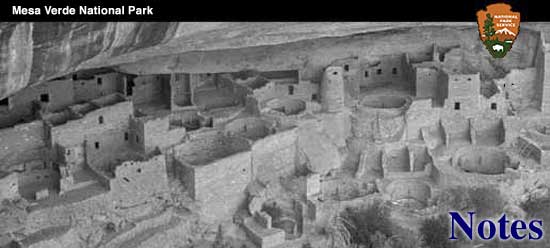

|
Prehistoric black-on-white pottery is found in many localities throughout the Southwest, but in most regions the bowls of this type of ware have no exterior ornamentation. For instance, in the three sub-cultures of the San Juan drainage, the Mesa Verde, the Chaco, and Kayenta, only the Mesa Verde is characterized by the exterior design.1
There are several pottery shapes in the collection of the Mesa Verde National Park Museum,— bowls, kiva jars, ladles, ollas, seed jars, and several other shapes of undetermined use, but the bowl is the only type that offers more than one ornamental surface by virtue of its shape. This therefore indicates a choice on the part of the maker of this variety. The park museum has thirty-seven bowls in its collection, all in good enough state of preservation to indicate very clearly any exterior design. Of this number twenty-six bowls have some type of ornamentation on the outside. Nordenskiold2 lists twenty-one bowls, only seven of which have some sort of exterior ornamentation, while the remaining fourteen are entirely undecorated on the outside. In contrast to the museum's collection which shows a strong tendency toward ornamentation on the outside, two thirds of Nordenskiold's collection has no exterior ornamentation what so-ever. This conclusion is emphasized by Nordenskiold in a descriptive note regarding a certain bowl. (Ibid, Plate XXVII, No. 1) "An exceptional point in this bowl is its possession of a design on the outside. I have observed very few instances of this among the bowls from the Mesa Verde."
Morris3 in his classification of pottery from the Aztec Ruins divides exterior ornamentation into two sub-divisions, continuous and non-continuous. In as much as the design on the outside of Mesa Verde pottery fits very compactly into these descriptive terms, it can be classified according to these two categories. "Continuous" the type in which the design forms a continuous band or zone (Figure 1) around the upper half of the bowl, and the "non-continuous" (Figure 2) the type in which the design consists of separate ornamental motifs evenly spaced at intervals around the upper half of the howl.
Of the twenty six bowls in the museums's collection which have exterior ornamentation, seventeen designs are continuous, nine are non-continuous. Nordenskiold's collection consists entirely of non-continuous designs. From the combined collections a complete analysis can be made of design motifs on the exterior of the Mesa Verde bowls, dealing first with the continuous type and secondly with the non-continuous type. All the designs have proved to to be geometrical with one exception, a bowl on which were placed placed at even intervals two birds, an animal, and an anthropomorphic figure similar to the Hopi God, Kokopelli.4
Designs of the continuous type consisted largely of meander figures which Chapman defines as a design composed in its simplest form of a line making constantly repeated changes of direction without crossing itself.
These meander patterns vary in the degree of complication and are combined in several instances with stepped figures or stars. For the most part there is not a great deal of variety in this type of exterior ornamentation, and the motifs resemble in many cases the interior designs except for the fact that they are not encased in framing lines. However of the several designs which are distinctly unusual only one is illustrated below in Figure 4.
The motifs in the non-continuous designs are complete a entities which vary widely. Many strongly suggest conventionalized butterflies and snakes, while others are obviously purely geometric. Examples occur of the cross, the swastika, and the interlocking spirals, together with innumerable combinations of oblique lines. The motifs illustrated in Figure 5 indicate the type of design found in this non-continuous class.
The larger number of black-on-white Mesa Verde Bowls which are decorated on the exterior would seem to indicate characteristics peculiar to the pottery of the Mesa Verde and offers a basis for differentiation in the prehistoric pottery of the San Juan area. -oOo- | ||||||
| <<< Previous | > Cover < | Next >>> |
vol3-3f.htm
14-Oct-2011